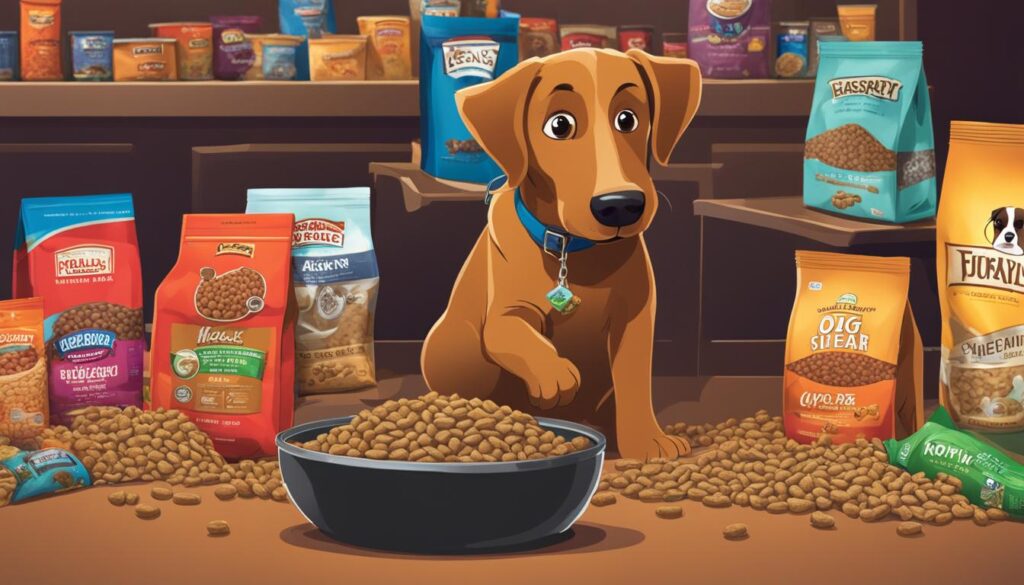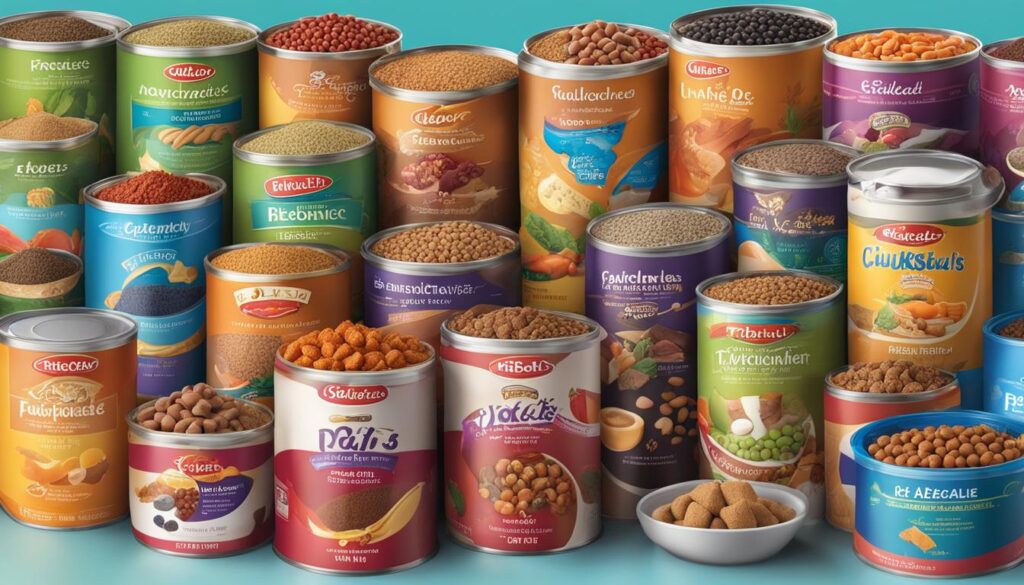Are you thinking about transitioning to a new dog food? It’s important to do it right to avoid any tummy troubles for your furry friend. Here are some tips for transitioning dog food smoothly.
Switching your dog’s food abruptly can lead to gastrointestinal upset, which nobody wants to deal with. To make the transition easier for your pup, gradually introduce the new food over 5-7 days. Start by mixing a small amount of the new food with their current food and slowly increase the ratio of new food to old food each day.
Keep a close eye on your dog during this transition period. If you notice any stomach upset or discomfort, it’s best to consult with your veterinarian. They can provide guidance and suggest alternative diet options if needed.
Remember, every dog is different, so the transition process may vary. Patience and monitoring your dog’s response are key to making the switch to a new dog food a success.
The Importance of a Proper Diet Transition
Switching your dog’s food brand or introducing a new type of dog food requires a careful and gradual transition to ensure a smooth change. Abruptly changing your dog’s diet can lead to gastrointestinal upset, including vomiting, diarrhea, and decreased appetite. A proper diet transition involves the gradual introduction of the new food while decreasing the old food over several days.
By following a transition schedule, you allow your dog’s digestive system to adjust to the new food without causing discomfort. This gradual approach helps prevent digestive issues and allows your dog to adapt to the new diet more easily. It is important to monitor your dog’s response during the transition period and make adjustments if needed.
“Properly transitioning your dog’s food is essential to avoid digestive upset and provide them with the nutrition they need.”
A successful transition to a new dog food involves paying attention to your dog’s individual needs and preferences. Some dogs may require a slower transition, while others may adapt more quickly. Sometimes, a trial and error process may be necessary to find the right food brand or type that suits your dog’s tastes and dietary requirements.
Remember, consulting with your veterinarian is always recommended when making any changes to your dog’s diet. They can provide guidance tailored to your dog’s specific needs and help ensure a successful transition to a new food brand or type.


Understanding Adverse Food Reactions in Dogs
Adverse food reactions in dogs encompass a range of food-related illnesses, including food allergies, food intolerance, and gastrointestinal diseases. These reactions can manifest in various ways, resulting in unpleasant symptoms for your furry friend. It’s important to recognize the signs and consult with your veterinarian for proper diagnosis and treatment.
Food Allergies
Food allergies in dogs occur when their immune system overreacts to certain ingredients in their diet. Common allergens include beef, dairy, chicken, wheat, and soy. When a dog ingests an allergen, it triggers an immune response that leads to symptoms such as itching, skin inflammation, rashes, vomiting, diarrhea, or changes in appetite. To manage food allergies, your veterinarian may recommend an elimination diet to identify the specific allergen and provide guidance on alternative diets.
Food Intolerance
In contrast to food allergies, food intolerance occurs when a dog has difficulty digesting certain ingredients. This can lead to gastrointestinal symptoms such as nausea, vomiting, diarrhea, or changes in appetite. Common culprits of food intolerance include lactose, gluten, and certain types of protein. Eliminating or reducing the problematic ingredient from your dog’s diet can help alleviate symptoms.
Gastrointestinal Diseases
Gastrointestinal diseases in dogs can be caused by various factors, including infections, inflammation, or underlying health conditions. These diseases can result in digestive issues, such as chronic diarrhea, vomiting, abdominal pain, and weight loss. Your veterinarian will perform diagnostic tests to determine the cause of the gastrointestinal disease and recommend appropriate treatment options.
| Adverse Food Reactions | Symptoms |
|---|---|
| Food Allergies | Itching, skin inflammation, rashes, vomiting, diarrhea, changes in appetite |
| Food Intolerance | Nausea, vomiting, diarrhea, changes in appetite |
| Gastrointestinal Diseases | Chronic diarrhea, vomiting, abdominal pain, weight loss |
Understanding the different types of adverse food reactions in dogs is crucial for identifying and addressing any potential issues. If you notice any concerning symptoms or suspect your dog may have an adverse reaction to their food, it’s best to consult with your veterinarian for proper guidance and treatment.
Monitoring Your Dog’s Digestive Health
One of the key indicators of your dog’s overall health is their digestive system. Monitoring your dog’s digestive health is essential to ensure they are thriving and free from any gastrointestinal issues. One way to assess their digestive health is by evaluating the quality of their stool.
Evaluating Stool Quality: A dog’s stool can provide valuable insights into their digestive health. While minor variations in color and consistency are normal, major changes might indicate an underlying problem. Using a fecal scoring chart can help assess your dog’s stool quality, with an ideal score between 3-4 indicating a healthy digestive system.
| Stool Score | Description |
|---|---|
| 1 | Watery or runny stool |
| 2 | Soft stool that lacks form |
| 3 | Well-formed stool that holds its shape |
| 4 | Firm, well-formed stool |
| 5 | Dry, hard stool |
Regularly monitoring your dog’s stool quality can help you identify any changes or abnormalities. If you consistently notice abnormal stool, such as frequent diarrhea, bloody stool, or persistent changes in color or consistency, it is crucial to consult with your veterinarian. They can evaluate your dog’s digestive health and determine the underlying cause of the issue.
Remember, your dog’s digestive health is closely linked to their overall well-being. By paying attention to their stool quality and seeking veterinary guidance when necessary, you can ensure your furry friend enjoys a happy and healthy digestive system.
Choosing the Right Dog Food
When it comes to choosing the right dog food for your furry friend, there are several factors to consider. With a wide range of options available in the market, it can be overwhelming to make the best choice. However, by following a few guidelines and debunking some common myths about dog food, you can ensure that you are providing your dog with a complete and balanced diet.
How to Choose Dog Food
One of the first things to consider when choosing dog food is your dog’s age and specific health needs. Puppies, adult dogs, and senior dogs have different nutritional requirements, so it’s important to select a food that caters to their stage of life. Additionally, if your dog has any health conditions or sensitivities, consulting with your veterinarian can help you find a suitable diet that addresses their specific needs.
Reading pet food labels is another crucial step in choosing the right dog food. Look for foods that are labeled as “complete and balanced,” as this means that the food meets the nutritional standards set by the Association of American Feed Control Officials (AAFCO). In addition to the AAFCO statement, check the ingredients list to ensure that the food contains high-quality protein sources, whole grains, fruits, and vegetables. Avoid foods that contain artificial additives, fillers, or by-products.
Myths About Dog Food
There are several myths surrounding dog food that can make the decision-making process confusing. One common myth is that grain-free diets are always better for dogs. While some dogs may have grain allergies or sensitivities, grains like rice and barley can be a healthy source of nutrients for many dogs. It’s important to choose a diet based on your individual dog’s needs rather than following trends or misconceptions.
Another myth is that all raw or homemade diets are superior to commercial dog food. While there are benefits to feeding a raw or homemade diet when properly formulated, it’s crucial to ensure that the diet is nutritionally balanced. Working with a veterinary nutritionist can help create a safe and balanced homemade diet, or you can choose a commercially available raw or cooked diet that has undergone rigorous testing.
Summary
Choosing the right dog food requires considering your dog’s age, health, and nutritional needs. By reading pet food labels and understanding the AAFCO guidelines for a complete and balanced diet, you can make an informed decision. It’s important to address any specific health concerns your dog may have and consult with your veterinarian for personalized recommendations. By debunking common myths and focusing on your dog’s individual needs, you can provide them with a nutritious and delicious diet.
| Myth about Dog Food | Fact |
|---|---|
| Grain-free diets are always better for dogs. | Grains can be a healthy source of nutrients for many dogs. |
| All raw or homemade diets are superior to commercial dog food. | Raw or homemade diets must be nutritionally balanced for optimal health. |
Transitioning Your Pet to a New Food
Switching your pet’s food is not a decision that should be taken lightly. There are various reasons why you may need to make the switch, such as a recommendation from your veterinarian, changes in dietary needs or preferences, or the unavailability of the current food. To ensure a smooth transition, it is important to follow these essential steps.
Troubleshooting and Safety Tips
- Gradual Transition: Start by mixing a small amount of the new food with your pet’s current food. Over the course of several days, gradually increase the proportion of the new food while decreasing the old food. This slow transition allows your pet’s digestive system to adjust.
- Monitor for Digestive Upset: Keep a close eye on your pet for any signs of gastrointestinal distress such as vomiting, diarrhea, or excessive gas. If your pet experiences any of these symptoms, consult with your veterinarian.
- Stick to a Schedule: Consistency is key when transitioning your pet to a new food. Establish a feeding schedule and make sure to feed your pet at the same times each day. This can help regulate their digestion and make the transition smoother.
- Avoid Overfeeding: It’s essential to feed your pet the appropriate amount of food during the transition period. Follow the feeding guidelines provided by the new food manufacturer and adjust as needed based on your pet’s age, weight, and activity level.
- Seek Professional Guidance: If you’re unsure about how to transition your pet to a new food or have any concerns, don’t hesitate to reach out to your veterinarian. They can provide personalized guidance and ensure that the switch is safe and appropriate for your pet’s specific needs.
Remember, transitioning your pet to a new food requires a gradual approach and close monitoring. Taking the time to make the switch properly can help minimize the risk of digestive upset and ensure a successful transition.
Table: Common Pet Food Ingredients to Avoid
| Ingredient | Potential Side Effects |
|---|---|
| Artificial Preservatives (BHA, BHT, Ethoxyquin) | Linked to allergies, cancer, and other health issues |
| Corn | Common allergen, lacks nutritional value |
| Soy | Potential allergen, may interfere with nutrient absorption |
| Wheat | Common allergen, lacks nutritional value |
| By-Product Meals | Low-quality protein source, may contain unspecified parts |


“Properly transitioning your pet’s food ensures a smooth switch and minimizes the risk of digestive upset. Follow a gradual transition schedule, monitor your pet’s response, and seek guidance from your veterinarian if needed.”
Finding the Best Food for Your Pet
When it comes to providing the best nutrition for your pet, selecting the right food is essential. Every pet has unique health and nutritional needs, so it’s important to choose a diet that meets their specific requirements. The Association of American Feed Control Officials (AAFCO) guidelines serve as a valuable resource in determining whether a pet food provides a complete and balanced diet.


To ensure that the food you choose meets these guidelines, look for the AAFCO statement on the label. This statement indicates that the food has undergone feeding trials to meet the nutritional standards established by AAFCO. Additionally, you can consult with your veterinarian to determine the most suitable food for your pet’s overall well-being.
Factors to Consider
When selecting the best food for your pet, there are several factors to consider. These include your pet’s age, breed, size, activity level, and any specific dietary needs or sensitivities they may have. Some pets may require specialized diets, such as those for weight management, joint health, or food allergies.
A complete and balanced diet should provide all the essential nutrients your pet needs to thrive, including proteins, carbohydrates, fats, vitamins, and minerals. Reading the ingredients list can give you insight into what goes into the food and whether it aligns with your pet’s nutritional requirements.
Consulting with Your Veterinarian
Your veterinarian is an invaluable resource when it comes to choosing the best food for your pet. They can provide tailored advice based on your pet’s specific needs and help you navigate the overwhelming array of options available. Your vet can also offer recommendations on reputable brands and guide you through any dietary transitions or adjustments.
In conclusion, finding the best food for your pet involves considering their individual needs, ensuring a complete and balanced diet, and consulting with your veterinarian for personalized guidance. By making informed choices about your pet’s nutrition, you can contribute to their overall health and well-being.
Conclusion
Transitioning to a new dog food can be a smooth and successful process if done correctly. By following a gradual transition schedule and closely monitoring your dog’s response, you can minimize the risk of gastrointestinal upset and other adverse reactions. Remember to always consult with your veterinarian for personalized guidance and recommendations when transitioning or selecting a new dog food.
Choosing the right food for your dog is crucial for their health and overall well-being. Consider their specific health and nutritional needs, and ensure the food meets the Association of American Feed Control Officials (AAFCO) guidelines for a complete and balanced diet. Your veterinarian is the best resource to help you determine the most suitable food for your dog.
So, whether you’re changing your dog’s food due to a recommendation, dietary needs, or preferences, or simply transitioning to a new food, remember to take it slow. By transitioning gradually and paying attention to your dog’s reactions, you can make the process smoother and more comfortable for them. With the right approach, you’ll be able to successfully transition your dog to a new food and support their overall health and well-being.
FAQ
How should I transition my dog to a new food?
Transitioning your dog to a new food requires a gradual approach. Over 5-7 days, gradually increase the amount of new food while decreasing the old food. Monitor your dog’s response and consult with your veterinarian if any stomach upset occurs.
What can happen if I abruptly switch my dog’s food?
Abruptly switching your dog’s food can lead to gastrointestinal upset, including vomiting, diarrhea, and decreased appetite. Properly transitioning your dog’s diet ensures a smooth and successful switch.
What are adverse food reactions in dogs?
Adverse food reactions encompass a range of food-related illnesses in dogs, including food allergies, food intolerance, and gastrointestinal diseases. These reactions can manifest as gastrointestinal symptoms and cutaneous symptoms.
How can I monitor my dog’s digestive health?
The quality of your dog’s stool is a good indicator of their digestive health. Minor variations are normal, but major changes might signal an underlying problem. Using a fecal scoring chart can help evaluate your dog’s stool, and any consistently abnormal stool should be discussed with your veterinarian.
How do I choose the right dog food?
Choosing the right dog food involves considering factors such as your dog’s age, health, and personal preferences. It is important to learn how to read pet food labels and understand the Association of American Feed Control Officials (AAFCO) guidelines for a complete and balanced diet.
Why would I need to switch my pet’s food?
There are various reasons why you may need to switch your pet’s food, such as a recommendation from your veterinarian, changes in dietary needs or preferences, or the unavailability of the current food. Making the switch gradually and monitoring your pet’s response is important.
How do I find the best food for my pet?
Determining the best food for your pet involves considering their specific health and nutritional needs. It is essential to choose a food that meets the AAFCO guidelines for a complete and balanced diet. Your veterinarian can provide personalized guidance and recommendations.

